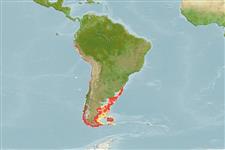Common names from other countries
Classification / Names / Names
Namen | Synonyme | Catalog of Fishes (gen., sp.) | ITIS | CoL | WoRMS
Environment: milieu / climate zone / depth range / distribution range
Ökologie
; brackwasser; tiefenbereich 0 - 100 m (Ref. 356), usually 4 - 20 m (Ref. 89833). Temperate, preferred 12°C (Ref. 107945); 7°S - 56°S, 81°W - 52°W
Southeast Pacific and Atlantic Ocean: From Pacasmayo, Peru to the Strait of Magellan and Beagle Channel including Juan Fernández Islands and to southern Brazil in the Atlantic including Falkland Islands. Introduced in the UK. Subtropical to temperate.
Length at first maturity / Size / Gewicht / Alter
Maturity: Lm ?, range 4 - 4 cm Max length : 26.0 cm SHL Männchen/unbestimmt; (Ref. 126826)
Found in bays. Found at depths of 4 to 8 m (Ref. 106875). Intertidal and subtidal sedimentary and rocky bottoms (Ref. 114788).
Life cycle and mating behavior
Geschlechtsreife | Fortpflanzung | Ablaichen | Eier | Fecundity | Larven
Members of the class Bivalvia are mostly gonochoric, some are protandric hermaphrodites. Life cycle: Embryos develop into free-swimming trocophore larvae, succeeded by the bivalve veliger, resembling a miniature clam.
SAUP Database. 2006. (Ref. 356)
IUCN Rote Liste Status (Ref. 130435)
CITES Status (Ref. 108899)
Not Evaluated
Not Evaluated
Nutzung durch Menschen
Fischereien: kommerziell
FAO - Aquakultur: production; Fischereien: landings | FishSource | Sea Around Us
Tools
Internet Quellen
Estimates based on models
Preferred temperature
(Ref.
115969): 7.5 - 20.5, mean 12.5 (based on 198 cells).
Verwundbarkeit
Low vulnerability (10 of 100).
